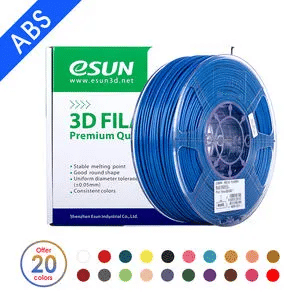Post-processing of ABS filament in 3D printing

3D printing technology has made rapid development in recent years, widely used in manufacturing, medical, construction and other fields. As one of the common 3D printing materials, ABS filament is favored for its high strength and good impact resistance. However, after printing is completed, the model of ABS filament often needs to go through a series of post-processing steps in order to achieve the desired surface effect and performance requirements. This article will introduce the processing skills of ABS filament after 3D printing in detail.
First of all, cleaning is the first step of post-treatment.
After the ABS filament printing is completed, the model needs to be removed from the printing platform, and the edge and top of the platform are wiped with paper towels to ensure that the platform is clean. The model is then cleaned using an ultrasonic cleaner or by hand. The ultrasonic cleaner efficiently removes impurities and residues from the surface of the model. Prepare two containers filled with 95% alcohol or IPA (isopropyl alcohol), wash the model in each container for about 1 to 2 minutes in turn, and then soak the model in an ultrasonic cleaner for 1 to 2 minutes. If you do not have an ultrasonic cleaner, you can prepare three containers and clean the model in turn for about 1 to 3 minutes, using a soft brush to gently brush the surface of the model for a better cleaning effect. Be careful to avoid using tools such as toothbrushes that may produce scratches.
Secondly, the removal of the support structure is also an important part of the post-processing of ABS filament printing.
The support structure is set to ensure that the model does not deform during the printing process, but will affect the surface quality of the model. The support structure can be removed using tools such as single-edge forceps, scalpels, and pen knives. For models that are prone to deformation, it is recommended to remove the support structure after secondary curing to avoid damage to the model.
Next, according to the characteristics of ABS filament, acetone steam can be used to smooth the surface.
Acetone can dissolve ABS material, thus achieving a smooth effect on the surface of the model. Get a paper towel, a small amount of acetone and a sealable container, place the paper towel at the bottom of the container, pour in a small amount of acetone, cover the bottom of the container with tin foil, and place the model in the container to seal for a few hours. When using acetone, be sure to pay attention to ventilation and wear protective gloves and gas masks, because acetone is toxic, flammable and explosive.
For the surface defects of ABS filament printing models, sandpaper can also be used to sand and polish them.
Use sandpaper with different mesh numbers (200 to 500 mesh) for preliminary grinding, gradually increase the number of sandpaper mesh (600, 800, 1000, 1200, 1500 mesh), and add water during the grinding process to improve the effect. After sanding, the model can be polished with toothpaste and a clean eyeglass cloth to restore the gloss.
In addition, there are some advanced post-treatment methods to choose from, such as shock polishing and pearlescent treatment.
Vibration polishing is achieved by vibration polishing machine or centrifugal polishing machine, using the collision friction between the medium and the model. The pearling treatment is to polish the surface of the model by spraying medium beads at high speed. The processing speed is fast, the effect is good, but the cost is high, and it is suitable for small size models.
Finally, depending on the specific needs, the electric heating tool can also be used to repair and remove the support material.
Similar to a soldering iron, this tool has multiple interchangeable heads and is easy to use, enabling easy removal of support materials and repair of surface defects at high temperatures.
In summary, the treatment of ABS filament after 3D printing includes several steps such as cleaning, removing the support structure, surface smoothing treatment, grinding and polishing. Through these post-processing techniques, the surface quality and performance of the model can be significantly improved to meet the needs of different application scenarios. With the continuous progress of 3D printing technology, more efficient and environmentally friendly post-processing methods will emerge in the future, providing strong support for the development of 3D printing technology.
- Art
- Causes
- Crafts
- Dance
- Drinks
- Film
- Fitness
- Food
- Игры
- Gardening
- Health
- Главная
- Literature
- Music
- Networking
- Другое
- Party
- Religion
- Shopping
- Sports
- Theater
- Wellness
- IT, Cloud, Software and Technology


